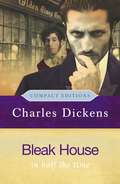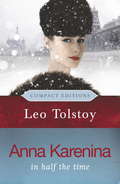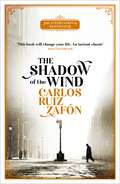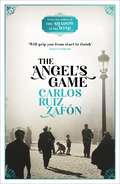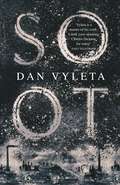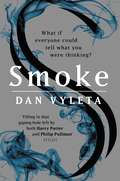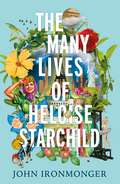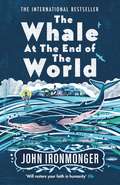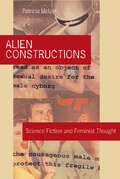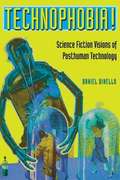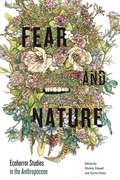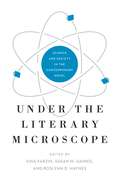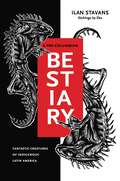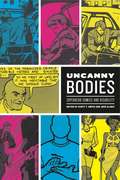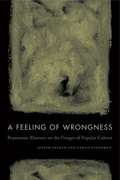- Table View
- List View
Bleak House: In Four Volumes, Volume 1...
by Charles DickensA tale of family secrets and the damaging corruption of the British legal system from the author of Great Expectations and Oliver Twist. <P><P> In this condensed version of Bleak House, Charles Dickens not only pries apart the stultifying and ponderous conduct and contracts of British moneyed society, but also takes specific aim at an English judicial system in desperate need of modernization and reform.<P> Featuring the voice of Esther Summerson—Dickens’s only female narrator—the story unfolds around a generations-old legal case involving numerous inheritances. It is Esther’s hidden birthright that sparks the drama, bringing to light such memorable characters as the Lady Dedlock, haunted by her shameful past; John Jarndyce, whose seemingly infinite kindness is driven by hidden guilt; and the sly lawyer Mr. Tulkinghorn, who secretly relishes the power his position gives him over his clients. <P>Weaving a complex web of plots and subplots, Dickens created one of his most dramatically satisfying and boldly ambitious narratives in Bleak House, as the novel offers a scathing indictment of the mores and moral injustices of his time.
Bleak House
by Charles DickensBleak House in half the timeEsther Summerson finds herself caught up in the frustrations of a seemingly unending law-case involving her generous guardian Mr Jarndyce and her wards Ada and Richard.Brought into contact with poverty and disease, Esther suffers a serious illness.Meanwhile the unscrupulous lawyer Tulkinghorn seeks to expose the past of the wife of a rich aristocrat, and the secret of Esther's birth is revealed. But in the midst of tumultuous events, will she ever find love?
Anna Karenina: Roman In 6 Büchern. - Primary Source Edition
by Leo TolstoyAnna Karenina in half the time Anna Karenina is the heart-wrenching tale of a woman who recklessly throws away everything she has for a passionate affair with a young soldier. Beautiful, popular, wife to a wealthy man and mother to an adored son, Anna seems to be in an enviable position. However, it takes only one encounter with Count Vronsky to fill her with the sense that her life has hitherto been empty. As the rest of the world fades into insignificance next to her great love, Anna faces an impossible choice¿
Anna Karenina
by Leo TolstoyAnna Karenina in half the timeAnna Karenina is the heart-wrenching tale of a woman who recklessly throws away everything she has for a passionate affair with a young soldier. Beautiful, popular, wife to a wealthy man and mother to an adored son, Anna seems to be in an enviable position.However, it takes only one encounter with Count Vronsky to fill her with the sense that her life has hitherto been empty. As the rest of the world fades into insignificance next to her great love, Anna faces an impossible choice¿
The Shadow of the Wind: The Cemetery of Forgotten Books 1
by Carlos Ruiz ZafonTHE MODERN CLASSIC: OVER 20 MILLION COPIES SOLDA Sunday Times bestseller and a Richard & Judy book club pick'The real deal: one gorgeous read' Stephen King'This book will change your life. An instant classic' Daily Telegraph'A book lover's dream' The Times Hidden in the heart of the old city of Barcelona is the 'Cemetery of Lost Books', a labyrinthine library of obscure and forgotten titles that have long gone out of print. To this library, a man brings his 10-year-old son Daniel one cold morning in 1945. Daniel is allowed to choose one book from the shelves and pulls out 'The Shadow of the Wind' by Julian Carax.But as he grows up, several people seem inordinately interested in his find. Then, one night, as he is wandering the old streets once more, Daniel is approached by a figure who reminds him of a character from the book, a character who turns out to be the devil. This man is tracking down every last copy of Carax's work in order to burn them. What begins as a case of literary curiosity turns into a race to find out the truth behind the life and death of Julian Carax and to save those he left behind...'Marvellous' Sunday Times'A hymn of praise to all the joys of reading' Independent'Gripping and instantly atmospheric' Mail on Sunday'Irresistibly readable' Guardian'Diabolically good' Elle
The Angel's Game: The Cemetery of Forgotten Books 2
by Carlos Ruiz ZafonThe stunning new novel from the internationally bestselling author of THE SHADOW OF THE WIND.In an abandoned mansion at the heart of Barcelona, a young man - David Martin - makes his living by writing sensationalist novels under a pseudonym. The survivor of a troubled childhood, he has taken refuge in the world of books, and spends his nights spinning baroque tales about the city's underworld. But perhaps his dark imaginings are not as strange as they seem, for in a locked room deep within the house letters hinting at the mysterious death of the previous owner. Like a slow poison, the history of the place seeps into his bones as he struggles with an impossible love. Then David receives the offer of a lifetime: he is to write a book with the power to change hearts and minds. In return, he will receive a fortune, perhaps more. But as David begins the work, he realises that there is a connection between this haunting book and the shadows that surround his home...
Soot: A Novel
by Dan VyletaWelcome to a world where every desire is visible, rising from the body as a plume of Smoke. A world where bodies speak to one another and infect each other with desire, anger, greed. It is 1909 and this world stands on a precipice - some celebrate this constant whisper of skin to skin, and some seek to silence it forever.Enter Eleanor, a young woman with a strange power over Smoke and niece of the Lord Protector of England. Running from her uncle and home, she finds shelter in a New York theatre troupe.Then Nil, a thief hiding behind a self-effacing name. He's an orphan snatched from a jungle-home and suspects that a clue to his origins may lie hidden in the vaults of the mighty, newly-risen East India Company.And finally Thomas, one of the three people to release Smoke into the world. On a clandestine mission to India, he hopes to uncover the origins of Smoke and lay to rest his doubts about what he helped to unleash.In a story that crosses continents - from India to England's Minetowns - these three seek to control the power of Smoke. As their destinies entwine, a cataclysmic confrontation looms: the Smoke will either bind them together or forever rend the world.
Smoke
by Dan VyletaImagine a world in which every bad thought you had was made visible. Where anger, hatred and envy appeared as a thick, infectious smoke pouring from your body, leaving soot on your skin. A society controlled by an elite who have learned to master their darkest desires.Thomas and Charlie are friends at a boarding school near Oxford, where the children of the rich and powerful are trained to be future leaders. Charlie is naturally good, but Thomas's father was accused of a terrible crime, and Thomas fears that the same evil lies coiled inside him. Then, on a trip to London - a forbidden city shrouded in darkness - they learn all is not as it appears. So begins a quest to understand the truth about this world of smoke, soot and ash - and perhaps to change it.'Mesmerising and imaginative ... a novel that tackles the most fundamental question of good versus evil' Hannah Beckerman, Observer'Like an adult version of the Harry Potter books with a touch of Dickensian dystopia ...a sheer delight' Maxim Jakubowski, Lovereading'A novel that stays in the imagination long after it is read' Adam Roberts, Guardian
Travelers Rest: A Novel
by Keith Lee Morris'ALICE IN WONDERLAND MEETS THE SHINING' Kirkus'A FINE ADDITION TO THE CREEPY HOTEL THRILLER GENRE' Independent'SHOULD YOU CHOOSE TO STAY A WHILE IN GOOD NIGHT, IDAHO, THEN - UNLIKE THE ADDISONS - YOU WON'T REGRET IT' GuardianThe Addisons - Julia and Tonio, ten-year-old Dewey, and Uncle Robbie - are driving home after collecting Robbie from yet another trip to rehab. When a terrifying blizzard strikes outside the town of Good Night, Idaho, they seek refuge at the Travelers Rest, a formerly opulent but now crumbling hotel.With nowhere else to go, they decide to stay the night. But once inside, the family becomes separated and the hotel begins to work its eerie magic. As Julia and Tonio drift through the maze of the hotel's spectral interiors, Dewey ventures outside. Meanwhile, a desperate Robbie quickly succumbs to his old vices. As they desperately try to reach each other, they relive the same day over and over again. The mother, Julia, holds the key to their release - but can she save her family from the fate of becoming Souvenirs - those citizens trapped forever in Good Night-or, worse, from disappearing entirely?
The Many Lives of Heloise Starchild
by John IronmongerREMEMBER ME WHEN THE COMET COMES...On the day the comet came, a girl named Heloise was born. She would live a fine life, and inherit a fortune, but would meet a cruel, untimely death. Years later, strange dreams plague Katya Nemcová, a teenager burdened with a rare and curious gift. Memories come to Katya in her dreams - images and stories from a past that isn't her own. Are these ghosts real? And what of the memory she seems to have of Heloise's treasures, two centuries old? A novel that spans the history of Europe - from revolutionary France to the world wars, the Prague Spring, post Brexit Britain, and beyond - this is the irresistible, adventurous and affectionate story of a quite extraordinary woman, her exceptionally talented ancestors, and the curious memories they share.
The Many Lives of Heloise Starchild
by John IronmongerREMEMBER ME WHEN THE COMET COMES...On the day the comet came, a girl named Heloise was born. She would live a fine life, and inherit a fortune, but would meet a cruel, untimely death. Years later, strange dreams plague Katya Nemcová, a teenager burdened with a rare and curious gift. Memories come to Katya in her dreams - images and stories from a past that isn't her own. Are these ghosts real? And what of the memory she seems to have of Heloise's treasures, two centuries old? A novel that spans the history of Europe - from revolutionary France to the world wars, the Prague Spring, post Brexit Britain, and beyond - this is the irresistible, adventurous and affectionate story of a quite extraordinary woman, her exceptionally talented ancestors, and the curious memories they share.
The Whale at the End of the World
by John IronmongerPreviously published as NOT FORGETTING THE WHALETHE INTERNATIONAL BESTSELLER'A gentle and uplifting tale of warding off apocalypse in a remote corner of Cornwall . . . charming' Financial TimesFor fans of ELEANOR OLIPHANT, THE ROSIE PROJECT & THE UNLIKELY PILGRIMAGE OF HAROLD FRY.It all began with the whale.When a young man washes up on the sands of St Piran in Cornwall, it is clear to the villagers that this is not a regular day. What has brought him here? And what is the crisis only he understands, that threatens not only their community but all of civilisation?With a global pandemic on the horizon, and a whale lurking in the bay, the villagers of St Piran must band together to survive. Intimate, funny and heart-warming, John Ironmonger tells a compelling story about the important things that hold us together, and how hope can be found, even at the end of the world.'Fun, uplifting, charming' Financial Times'A warm-hearted book crammed with ideas . . . very, very good' Emerald Street'A tremendously enjoyable book' Independent on Sunday
Not Forgetting the Whale
by John IronmongerWHERE WILL YOU ESCAPE TO THIS SUMMER? For fans of ELEANOR OLIPHANT, THE ROSIE PROJECT & THE UNLIKELY PILGRIMAGE OF HAROLD FRY, an uplifting story about the search for a place to belong. When a young man, Joe, washes up on the sands of St Piran in Cornwall, he is quickly rescued by the villagers. From the retired village doctor and the beachcomber, to the priest's wife and the flamboyant romantic novelist, they take this lost soul into their midst. And they, in turn, come to find that he gives fresh perspectives on their lives and loves. But what the villagers don't know is why Joe fled the city for St Piran, and what he left behind. Intimate, funny and heart-warming, Not Forgetting the Whale is a story about community, the best and worst in our nature, and the search for a place to call home.'Fun, uplifting, charming' Financial Times'A warm-hearted book crammed with ideas . . . very, very good' Emerald Street'A tremendously enjoyable book' Independent on Sunday
Alien Constructions: Science Fiction and Feminist Thought
by Patricia MelzerThough set in other worlds populated by alien beings, science fiction is a site where humans can critique and re-imagine the paradigms that shape this world, from fundamentals such as the sex and gender of the body to global power relations among sexes, races, and nations. Feminist thinkers and writers are increasingly recognizing science fiction's potential to shatter patriarchal and heterosexual norms, while the creators of science fiction are bringing new depth and complexity to the genre by engaging with feminist theories and politics. This book maps the intersection of feminism and science fiction through close readings of science fiction literature by Octavia E. Butler, Richard Calder, and Melissa Scott and the movies The Matrix and the Alien series. Patricia Melzer analyzes how these authors and films represent debates and concepts in three areas of feminist thought: identity and difference, feminist critiques of science and technology, and the relationship among gender identity, body, and desire, including the new gender politics of queer desires, transgender, and intersexed bodies and identities. She demonstrates that key political elements shape these debates, including global capitalism and exploitative class relations within a growing international system; the impact of computer, industrial, and medical technologies on women's lives and reproductive rights; and posthuman embodiment as expressed through biotechnologies, the body/machine interface, and the commodification of desire. Melzer's investigation makes it clear that feminist writings and readings of science fiction are part of a feminist critique of existing power relations—and that the alien constructions (cyborgs, clones, androids, aliens, and hybrids) that populate postmodern science fiction are as potentially empowering as they are threatening.
Alien Constructions: Science Fiction and Feminist Thought
by Patricia MelzerThough set in other worlds populated by alien beings, science fiction is a site where humans can critique and re-imagine the paradigms that shape this world, from fundamentals such as the sex and gender of the body to global power relations among sexes, races, and nations. Feminist thinkers and writers are increasingly recognizing science fiction's potential to shatter patriarchal and heterosexual norms, while the creators of science fiction are bringing new depth and complexity to the genre by engaging with feminist theories and politics. This book maps the intersection of feminism and science fiction through close readings of science fiction literature by Octavia E. Butler, Richard Calder, and Melissa Scott and the movies The Matrix and the Alien series. Patricia Melzer analyzes how these authors and films represent debates and concepts in three areas of feminist thought: identity and difference, feminist critiques of science and technology, and the relationship among gender identity, body, and desire, including the new gender politics of queer desires, transgender, and intersexed bodies and identities. She demonstrates that key political elements shape these debates, including global capitalism and exploitative class relations within a growing international system; the impact of computer, industrial, and medical technologies on women's lives and reproductive rights; and posthuman embodiment as expressed through biotechnologies, the body/machine interface, and the commodification of desire. Melzer's investigation makes it clear that feminist writings and readings of science fiction are part of a feminist critique of existing power relations—and that the alien constructions (cyborgs, clones, androids, aliens, and hybrids) that populate postmodern science fiction are as potentially empowering as they are threatening.
Technophobia!: Science Fiction Visions of Posthuman Technology
by Daniel DinelloTechno-heaven or techno-hell? If you believe many scientists working in the emerging fields of twenty-first-century technology, the future is blissfully bright. Initially, human bodies will be perfected through genetic manipulation and the fusion of human and machine; later, human beings will completely shed the shackles of pain, disease, and even death, as human minds are downloaded into death-free robots whereby they can live forever in a heavenly "posthuman" existence. In this techno-utopian future, humanity will be saved by the godlike power of technology. If you believe the authors of science fiction, however, posthuman evolution marks the beginning of the end of human freedom, values, and identity. Our dark future will be dominated by mad scientists, rampaging robots, killer clones, and uncontrollable viruses. In this timely new book, Daniel Dinello examines "the dramatic conflict between the techno-utopia promised by real-world scientists and the techno-dystopia predicted by science fiction."
Fear and Nature: Ecohorror Studies in the Anthropocene (AnthropoScene: The SLSA Book Series #8)
by Christy Tidwell Carter SolesEcohorror represents human fears about the natural world—killer plants and animals, catastrophic weather events, and disquieting encounters with the nonhuman. Its portrayals of animals, the environment, and even scientists build on popular conceptions of zoology, ecology, and the scientific process. As such, ecohorror is a genre uniquely situated to address life, art, and the dangers of scientific knowledge in the Anthropocene.Featuring new readings of the genre, Fear and Nature brings ecohorror texts and theories into conversation with other critical discourses. The chapters cover a variety of media forms, from literature and short fiction to manga, poetry, television, and film. The chronological range is equally varied, beginning in the nineteenth century with the work of Edgar Allan Poe and finishing in the twenty-first with Stephen King and Guillermo del Toro. This range highlights the significance of ecohorror as a mode. In their analyses, the contributors make explicit connections across chapters, question the limits of the genre, and address the ways in which our fears about nature intersect with those we hold about the racial, animal, and bodily "other."A foundational text, this volume will appeal to specialists in horror studies, Gothic studies, the environmental humanities, and ecocriticism.In addition to the editors, the contributors include Kristen Angierski, Bridgitte Barclay, Marisol Cortez, Chelsea Davis, Joseph K. Heumann, Dawn Keetley, Ashley Kniss, Robin L. Murray, Brittany R. Roberts, Sharon Sharp, and Keri Stevenson.
Fear and Nature: Ecohorror Studies in the Anthropocene (AnthropoScene)
by Christy Tidwell Carter SolesEcohorror represents human fears about the natural world—killer plants and animals, catastrophic weather events, and disquieting encounters with the nonhuman. Its portrayals of animals, the environment, and even scientists build on popular conceptions of zoology, ecology, and the scientific process. As such, ecohorror is a genre uniquely situated to address life, art, and the dangers of scientific knowledge in the Anthropocene.Featuring new readings of the genre, Fear and Nature brings ecohorror texts and theories into conversation with other critical discourses. The chapters cover a variety of media forms, from literature and short fiction to manga, poetry, television, and film. The chronological range is equally varied, beginning in the nineteenth century with the work of Edgar Allan Poe and finishing in the twenty-first with Stephen King and Guillermo del Toro. This range highlights the significance of ecohorror as a mode. In their analyses, the contributors make explicit connections across chapters, question the limits of the genre, and address the ways in which our fears about nature intersect with those we hold about the racial, animal, and bodily “other.”A foundational text, this volume will appeal to specialists in horror studies, Gothic studies, the environmental humanities, and ecocriticism.In addition to the editors, the contributors include Kristen Angierski, Bridgitte Barclay, Marisol Cortez, Chelsea Davis, Joseph K. Heumann, Dawn Keetley, Ashley Kniss, Robin L. Murray, Brittany R. Roberts, Sharon Sharp, and Keri Stevenson.
Under the Literary Microscope: Science and Society in the Contemporary Novel (AnthropoScene: The SLSA Book Series #7)
by Sina Farzin Roslynn D. Haynes Susan M. Gaines"Science in fiction," "geek novels," "lab-lit"—whatever one calls them, a new generation of science novels has opened a space in which the reading public can experience and think about the powers of science to illuminate nature as well as to generate and mitigate social change and risks. Under the Literary Microscope examines the implications of the discourse taking place in and around this creative space.Exploring works by authors as disparate as Barbara Kingsolver, Richard Powers, Ian McEwan, Ann Patchett, Margaret Atwood, and Michael Crichton, these essays address the economization of scientific institutions; ethics, risk, and gender disparity in scientific work; the reshaping of old stereotypes of scientists; science in an evolving sci-fi genre; and reader reception and potential contributions of the novels to public understandings of science.Under the Literary Microscope illuminates the new ways in which fiction has been grappling with scientific issues—from climate change and pandemics to artificial intelligence and genomics—and makes a valuable addition to both contemporary literature and science studies courses.In addition to the editors, the contributors include Anna Auguscik, Jay Clayton, Carol Colatrella, Sonja Fücker, Raymond Haynes, Luz María Hernández Nieto, Emanuel Herold, Karin Hoepker, Anton Kirchhofer, Antje Kley, Natalie Roxburgh, Uwe Schimank, Sherryl Vint, and Peter Weingart.
Under the Literary Microscope: Science and Society in the Contemporary Novel (AnthropoScene #7)
by Sina Farzin Roslynn D. Haynes Susan M. Gaines“Science in fiction,” “geek novels,” “lab-lit”—whatever one calls them, a new generation of science novels has opened a space in which the reading public can experience and think about the powers of science to illuminate nature as well as to generate and mitigate social change and risks. Under the Literary Microscope examines the implications of the discourse taking place in and around this creative space.Exploring works by authors as disparate as Barbara Kingsolver, Richard Powers, Ian McEwan, Ann Patchett, Margaret Atwood, and Michael Crichton, these essays address the economization of scientific institutions; ethics, risk, and gender disparity in scientific work; the reshaping of old stereotypes of scientists; science in an evolving sci-fi genre; and reader reception and potential contributions of the novels to public understandings of science.Under the Literary Microscope illuminates the new ways in which fiction has been grappling with scientific issues—from climate change and pandemics to artificial intelligence and genomics—and makes a valuable addition to both contemporary literature and science studies courses.In addition to the editors, the contributors include Anna Auguscik, Jay Clayton, Carol Colatrella, Sonja Fücker, Raymond Haynes, Luz María Hernández Nieto, Emanuel Herold, Karin Hoepker, Anton Kirchhofer, Antje Kley, Natalie Roxburgh, Uwe Schimank, Sherryl Vint, and Peter Weingart.
A Pre-Columbian Bestiary: Fantastic Creatures of Indigenous Latin America
by Ilan StavansAn encyclopedic collaboration between award-winning Mexican American scholar Ilan Stavans and illustrator Eko, A Pre-Columbian Bestiary features lively and informative descriptions of forty-six religious, mythical, and imaginary creatures from the Nahua, Aztec, Maya, Tabasco, Inca, Aymara, and other cultures of Latin America.From the siren-like Acuecuéyotl and the water animal Chaac to the class-conscious Oc and the god of light and darkness Xólotl, the magnificent entities in this volume belong to the same family of real and invented creatures imagined by Dante, Franz Kafka, C. S. Lewis, Jorge Luis Borges, Umberto Eco, and J. K. Rowling. They are mined from indigenous religious texts, like the Popol Vuh, and from chronicles, both real and fictional, of the Spanish conquest by Diego Durán, Bernal Díaz del Castillo, and Fernando de Zarzamora, among others. In this playful compilation, Stavans distills imagery from the work of magic realist masters such as Juan Rulfo and Gabriel García Márquez; from songs of protest in Mexico, Guatemala, and Peru; and from aboriginal beasts in Jewish, Muslim, European, British, and other traditions. In the spirit of imaginative invention, even the bibliography is a mixture of authentic and concocted material.An inspiring record of resistance and memory from a civilization whose superb pantheon of myths never ceases to amaze, A Pre-Columbian Bestiary will delight anyone interested in the history and culture of Latin America.
A Pre-Columbian Bestiary: Fantastic Creatures of Indigenous Latin America
by Ilan StavansAn encyclopedic collaboration between award-winning Mexican American scholar Ilan Stavans and illustrator Eko, A Pre-Columbian Bestiary features lively and informative descriptions of forty-six religious, mythical, and imaginary creatures from the Nahua, Aztec, Maya, Tabasco, Inca, Aymara, and other cultures of Latin America.From the siren-like Acuecuéyotl and the water animal Chaac to the class-conscious Oc and the god of light and darkness Xólotl, the magnificent entities in this volume belong to the same family of real and invented creatures imagined by Dante, Franz Kafka, C. S. Lewis, Jorge Luis Borges, Umberto Eco, and J. K. Rowling. They are mined from indigenous religious texts, like the Popol Vuh, and from chronicles, both real and fictional, of the Spanish conquest by Diego Durán, Bernal Díaz del Castillo, and Fernando de Zarzamora, among others. In this playful compilation, Stavans distills imagery from the work of magic realist masters such as Juan Rulfo and Gabriel García Márquez; from songs of protest in Mexico, Guatemala, and Peru; and from aboriginal beasts in Jewish, Muslim, European, British, and other traditions. In the spirit of imaginative invention, even the bibliography is a mixture of authentic and concocted material.An inspiring record of resistance and memory from a civilization whose superb pantheon of myths never ceases to amaze, A Pre-Columbian Bestiary will delight anyone interested in the history and culture of Latin America.
Uncanny Bodies: Superhero Comics and Disability (Graphic Medicine #18)
by Scott T. Smith José AlanizSuperhero comics reckon with issues of corporeal control. And while they commonly deal in characters of exceptional or superhuman ability, they have also shown an increasing attention and sensitivity to diverse forms of disability, both physical and cognitive. The essays in this collection reveal how the superhero genre, in fusing fantasy with realism, provides a visual forum for engaging with issues of disability and intersectional identity (race, ethnicity, class, gender, and sexuality) and helps to imagine different ways of being in the world.Working from the premise that the theoretical mode of the uncanny, with its interest in what is simultaneously known and unknown, ordinary and extraordinary, opens new ways to think about categories and markers of identity, Uncanny Bodies explores how continuums of ability in superhero comics can reflect, resist, or reevaluate broader cultural conceptions about disability. The chapters focus on lesser-known characters—such as Echo, Omega the Unknown, and the Silver Scorpion—as well as the famous Barbara Gordon and the protagonist of the acclaimed series Hawkeye, whose superheroic uncanniness provides a counterpoint to constructs of normalcy. Several essays explore how superhero comics can provide a vocabulary and discourse for conceptualizing disability more broadly. Thoughtful and challenging, this eye-opening examination of superhero comics breaks new ground in disability studies and scholarship in popular culture.In addition to the editors, the contributors are Sarah Bowden, Charlie Christie, Sarah Gibbons, Andrew Godfrey-Meers, Marit Hanson, Charles Hatfield, Naja Later, Lauren O’Connor, Daniel J. O'Rourke, Daniel Pinti, Lauranne Poharec, and Deleasa Randall-Griffiths.
Uncanny Bodies: Superhero Comics and Disability (Graphic Medicine)
by Scott T. Smith José AlanizSuperhero comics reckon with issues of corporeal control. And while they commonly deal in characters of exceptional or superhuman ability, they have also shown an increasing attention and sensitivity to diverse forms of disability, both physical and cognitive. The essays in this collection reveal how the superhero genre, in fusing fantasy with realism, provides a visual forum for engaging with issues of disability and intersectional identity (race, ethnicity, class, gender, and sexuality) and helps to imagine different ways of being in the world.Working from the premise that the theoretical mode of the uncanny, with its interest in what is simultaneously known and unknown, ordinary and extraordinary, opens new ways to think about categories and markers of identity, Uncanny Bodies explores how continuums of ability in superhero comics can reflect, resist, or reevaluate broader cultural conceptions about disability. The chapters focus on lesser-known characters—such as Echo, Omega the Unknown, and the Silver Scorpion—as well as the famous Barbara Gordon and the protagonist of the acclaimed series Hawkeye, whose superheroic uncanniness provides a counterpoint to constructs of normalcy. Several essays explore how superhero comics can provide a vocabulary and discourse for conceptualizing disability more broadly. Thoughtful and challenging, this eye-opening examination of superhero comics breaks new ground in disability studies and scholarship in popular culture.In addition to the editors, the contributors are Sarah Bowden, Charlie Christie, Sarah Gibbons, Andrew Godfrey-Meers, Marit Hanson, Charles Hatfield, Naja Later, Lauren O’Connor, Daniel J. O'Rourke, Daniel Pinti, Lauranne Poharec, and Deleasa Randall-Griffiths.
A Feeling of Wrongness: Pessimistic Rhetoric on the Fringes of Popular Culture
by Joseph Packer Ethan StonemanIn A Feeling of Wrongness, Joseph Packer and Ethan Stoneman confront the rhetorical challenge inherent in the concept of pessimism by analyzing how it is represented in an eclectic range of texts on the fringes of popular culture, from adult animated cartoons to speculative fiction.Packer and Stoneman explore how narratives such as True Detective, Rick and Morty, Final Fantasy VII, Lovecraftian weird fiction, and the pop ideology of transhumanism are better suited to communicate pessimistic affect to their fans than most carefully argued philosophical treatises and polemics. They show how these popular nondiscursive texts successfully circumvent the typical defenses against pessimism identified by Peter Wessel Zapffe as distraction, isolation, anchoring, and sublimation. They twist genres, upend common tropes, and disturb conventional narrative structures in a way that catches their audience off guard, resulting in belief without cognition, a more rhetorically effective form of pessimism than philosophical pessimism.While philosophers and polemicists argue for pessimism in accord with the inherently optimistic structures of expressive thought or rhetoric, Packer and Stoneman show how popular texts are able to communicate their pessimism in ways that are paradoxically freed from the restrictive tools of optimism. A Feeling of Wrongness thus presents uncharted rhetorical possibilities for narrative, making visible the rhetorical efficacy of alternate ways and means of persuasion.
